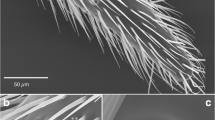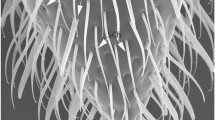Summary
-
1.
There are seven types of sensilla on the antenna of Lasius fuliginosus, and only the sense cells of the sensilla trichodea curvata reacted to odour stimuli.
-
2.
The structure of the sensilla trichodea curvata was investigated with light microscope. This type of sensilla is innervated by 20–30 sense cells.
-
3.
The number and distribution of the sensilla trichodea curvata on the antennal flagellum of workers and males of Lasius fuliginosus was described. Both casts have nearly 300 sensilla of this type on their whole antennal flagellum. On the antenna of workers 50% and on the antenna of males 20% of these sensilla are on the last antennal segment.
-
4.
In extracellular single-cell recordings the cells of the sensilla trichodea curvata reacted to alkanes, alcohols, aldehydes, amines ketones, fatty acids, esters and terpenes. All the investigated 12 alarm substances induced reaction; most of them increased, one of them (n-tridecane) inhibited the impulse frequency of nerve cells.
-
5.
With regard to the spectra of the sense cells of the sensilla trichodea curvate the substances which resulted in excitation could be devided into 10 reaction groups. There was almost no overlap among these reaction groups.
-
6.
Some single cells of the sensilla trichodea curvata reacted most specifically to n-undecane: The threshold for decane and dodecane was 103 and the threshold for 2-methyl-1-undecan was 104-fold higher than the threshold for undecane.
-
7.
In behavioral experiments n-undecane functions as an alarm substance for workers of Lasius fuliginosus.
-
8.
The species-specificity of alarm substances of ants in general and the cell-specificity of the receptors for the alarm substances of Lasius fuliginosus are discussed.
Zusammenfassung
-
1.
Unter den sieben Typen antennaler Sensillen von Lasius fuliginosus reagierten nur die Zellen des Sensillum trichodeum curvatum auf Geruchsreize.
-
2.
Der Bau der Sensilla trichodea curvata wurde lichtmikroskopisch untersucht. Innerviert wird dieser Sensillentyp von 20–30 Sinneszellen.
-
3.
Zahl und Verteilung der Sensilla trichodea curvata auf die Antennengeißel von Arbeiterinnen und Männchen von Lasius fuliginosus wurden ermittelt. Beide Kasten besitzen auf der gesamten Antennengeißel übereinstimmend knapp 300 Sensillen dieses Typs. Bei der Arbeiterin liegen 50%, beim Männchen 20% dieser Sensillen auf dem letzten Geißelsegment.
-
4.
In extrazellulären Einzelzellableitungen reagierten Zellen der Sensilla trichodea curvata auf Alkane, Alkohole, Aldehyde, Amine, Ketone, Fettsäuren, Ester und Terpene. Alle 12 geprüften Alarmsubstanzen waren wirksam; die meisten erhöhten, eine (n-Tridecan) verminderte die Zellaktivität (Zahl der Nervenimpulse).
-
5.
Nach den Spektren der Sinneszellen der Sensilla trichodea curvata ließen sich die erregenden Substanzen in 10 Reaktionsgruppen ordnen. Zwischen diesen Reaktionsgruppen wurden im wesentlichen keine Überlappungen gefunden.
-
6.
Einzelne Zellen der Sensilla trichodea curvata reagierten hochspezialisiert auf n-Undecan: Die Schwelle für Decan und Dodecan lag um drei Zehnerpotenzen und die für 2-Methyl-1-undecan um vier Zehnerpotenzen über der für Undecan.
-
7.
Im Verhaltensversuch wirkte n-Undecan als Alarmsubstanz auf Arbeiterinnen von Lasius fuliginosus.
-
8.
Die Artspezifität von Alarmsubstanzen bei Ameisen und die Zellspezifität des Alarmstoffrezeptors bei Lasius fuliginosus werden diskutiert.
Similar content being viewed by others
Literatur
Amoore, J. E., Palmieri, G., Wanke, E., Blum, M. S.: Ant alarm pheromone activity: correlation with molecular shape by scanning computer. Science 165, 1266–1269 (1969).
Bergström, G., Löfqvist, J.: Chemical basis for odour communication in four species of Lasius ants. J. Insect Physiol. 16, 2353–2375 (1970).
Bernardi, C., Cardani, D., Ghiringhelli, D., Selva, A., Baggini, A., Pavan, M.: On the components of secretion of mandibular glands of the ant Lasius (Dendrolasius) fuliginosus. Tetrahedron Letters 40, 3893–3896 (1967).
Blum, M. S.: Alarm pheromones. Ann. Rev. Entomol. 14, 57–80 (1969).
—: The chemical basis of insect sociality. In: Chemicals controlling insect behavior (M. Beroza, ed.), p. 61–94. New York, London: Academic Press 1970.
Boeckh, J.: Elektrophysiologische Untersuchungen an einzelnen Geruchsrezeptoren auf den Antennen des Totengräbers (Necrophorus, Coleoptera). Z. vergl. Physiol. 46. 212–248 (1962).
Dumpert, K.: (In Vorbereitung).
Forel, A.: Études myrmicologiques en 1884, avec une description des organes sensoriels des antennes. Bull. Soc. Vand. 20, 316–380 (1884).
Gabba, A., Pavan, M.: Researches on trail and alarm substances in ants. In: Advances in chemoreception, vol I. J. W. Johnston, Jr., D. G. Moulton and A. Turk, eds. p. 161–203. New York: ACC 1970.
Hölldobler, B.: Chemische Verständigung im Insektenstaat am Beispeil der Hautflügler (Hymenoptera). Umschau 21, 663–669 (1970).
Jaisson, P.: Études de la distribution des organes sensoriels de l'antenne et de leurs relations possibles avec le comportement chez deux fourmis Myrmicines: Myrmica laevinodis Nyl. et Aphaenogaster gibbosa Latr. recoltées dans la région des Eyzies. Ins. soc. 16, 279–312 (1969).
Kafka, W. A.: Molekulare Wechselwirkungen bei der Erregung einzelner Riechzellen. Z. vergl. Physiol. 70, 105–143 (1970).
Kaissling, K.-E.: Insect olfaction. In: Handbook of sensory physiology, H. Autrum R. Jung, W. R. Loewenstein, D. M. Mac Kay, H. L. Teuber, eds., vol. IV: Chemical senses, part 1: Olfaction (L. M. Beidler, ed.), p. 351–431. Berlin-Heidelberg-New York: Springer 1971).
Krausse, A. H.: Die antennalen Sinnesorgane der Ameisen, in ihrer Zahl und Verteilung bei den Geschlechtern und Individuen einiger Arten. Dissert. Jena, 40 S., 8 Abb. 1907.
Kürschner, I.: Über den Bau der Antenne von Formica pratensis Retzius, unter besonderer Berücksichtigung der Sensillen. Beitr. Entomol. 19, 273–280 (1969).
Lacher, V.: Elektrophysiologische Untersuchungen an einzelnen Rezeptoren für Geruch, Kohlendioxid, Luftfeuchtigkeit und Temperatur auf den Antennnen der Arbeitsbiene und der Drohne (Apis mellifica). Z. vergl. Physiol. 48, 587–623 (1964).
Maschwitz, U.: Gefahrenalarmstoffe und Gefahrenalarmierung bei sozialen Hymenopteren. Z. vergl. Physiol. 47, 596–655 (1964).
Pavan, M.: Studi sui Formicidae. I. Contributo alla eonoscenza degli organi gastrali nei Dolichoderinae. Natura (Milano), 46, 135–145 (1955).
—: Studi sui Formicidae. II. Sull' origine, significato biologico e isolamento della dendrolasina. Ric. Scien. 26, 144–150 (1956).
Quilico, A., Piozzi, F., Pavan, M.: Sulla dendrolasina. Ric. Scien. 26, 177–180 (1956).
Regnier, F. E., Wilson, E. O.: The alarm-defence system of the ant Acanthomyops claviger. J. Insect Physiol. 14, 955–970 (1968).
—: The alarm-defence system of the ant Lasius alienus. J. Insect Physiol. 15, 893–898 (1969).
Romeis, B.: Mikroskopische Technik. München, Leipzig: R. Oldenbourg 1968.
Rowell, C. H. F.: A general method for silvering invertebrate central nervous system. Quart. J. micr. Sci. 104, 81–87 (1963).
Schneider, D.: Elektrophysiologische Untersuchungen von Chemo und Mechanorezeptoren der Antenne des Seidenspinners Bombyx mori L. Z. vergl. Physiol. 40, 8–44 (1967).
Vareschi, E.: Duftunterscheidung bei der Honigbiene, Einzelzellableitung und Verhaltensreaktion. Z. vergl. Physiol. 75, 143–173 (1971).
Wilson, E. O.: The social biology of ants. Ann. Rev. Entomol. 8, 345–368 (1963).
—, Bossert, W. H.: Chemical communication among animals. Recent Progr. Hormone Res. 19, 673–716 (1963).
Author information
Authors and Affiliations
Additional information
Herr Prof. Dr. D. Schneider hat diese Arbeit angeregt. Ihm und meinen Kollegen aus der Arbeitsgruppe danke ich für wertvolle Diskussionen.
Rights and permissions
About this article
Cite this article
Dumpert, K. Alarmstoffrezeptoren auf der Antenne von Lasius fuliginosus (Latr.) (Hymenoptera, Formicidae). Z. vergl. Physiologie 76, 403–425 (1972). https://doi.org/10.1007/BF00337782
Received:
Issue Date:
DOI: https://doi.org/10.1007/BF00337782




